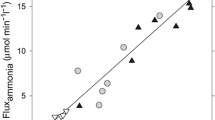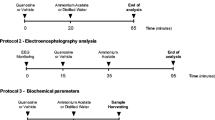Abstract
Acute liver failure (ALF) can lead to brain edema, cerebral hyperperfusion and intracranial hypertension. These complications are thought to be mediated by hyperammonemia and inflammation leading to altered brain metabolism. As increased levels of adenosine degradation products have been found in brain tissue of patients with ALF we investigated whether hyperammonemia could induce adenosine release in brain tissue. Since adenosine is a potent vasodilator and modulator of cerebral metabolism we furthermore studied the effect of adenosine receptor ligands on intracranial pressure (ICP) and cerebral blood flow (CBF). We measured the adenosine concentration with biosensors in rat brain slices exposed to ammonia and in a rat model with hyperammonemia and systemic inflammation. Exposure to ammonia in concentrations from 0.15–10 mM led to increases in the cortical adenosine concentration up to 18 µM in brain slices. In vivo recordings showed a tendency towards increased adenosine levels in rats with hyperammonemia and systemic inflammation compared to a control group (3.7 ± 0.7 vs. 0.8 ± 0.2 µM, P = 0.06). This was associated with a significant increase in ICP and CBF. Intervention with the non-selective adenosine receptor antagonist theophyllamine, the A2A receptor antagonist ZM241385, or the A1 receptor agonist N6-Cyclopentyladenosine did not reduce ICP or CBF. In conclusion, our results show that the adenosine concentration in cortex increases during exposure to ammonia, and is associated with a rise in intracranial pressure and cerebral perfusion. However adenosine receptor antagonism/agonism did not reduce the ICP or CBF which indicates that adenosine may not be of direct importance for these cerebral complications in ALF.



Similar content being viewed by others
References
Bjerring PN, Eefsen M, Hansen BA, Larsen FS (2009) The brain in acute liver failure. A tortuous path from hyperammonemia to cerebral edema. Metab Brain Dis 24(1):5–14
Bjerring PN, Larsen FS (2013) Changes in cerebral oxidative metabolism in patients with acute liver failure. Metab Brain Dis 28(2):179–182
Bjerring PN, Hauerberg J, Jorgensen L, Frederiksen HJ, Tofteng F, Hansen BA et al (2010) Brain hypoxanthine concentration correlates to lactate/pyruvate ratio but not intracranial pressure in patients with acute liver failure. J Hepatol 53(6):1054–1058
Phillis JW (2004) Adenosine and adenine nucleotides as regulators of cerebral blood flow: roles of acidosis, cell swelling, and KATP channels. Crit Rev Neurobiol 16(4):237–270
Klinger M, Freissmuth M, Nanoff C (2002) Adenosine receptors: g protein-mediated signalling and the role of accessory proteins. Cell Signal 14(2):99–108
Shin HK, Park SN, Hong KW (2000) Implication of adenosine A(2A) receptors in hypotension-induced vasodilation and cerebral blood flow autoregulation in rat pial arteries. Life Sci 67(12):1435–1445
Schubert P, Ogata T, Marchini C, Ferroni S, Rudolphi K (1997) Protective mechanisms of adenosine in neurons and glial cells. Ann N Y Acad Sci 15(825):1–10
Baumgold J, Nikodijevic O, Jacobson KA (1992) Penetration of adenosine antagonists into mouse brain as determined by ex vivo binding. Biochem Pharmacol 43(4):889–894
Morii S, Ngai AC, Ko KR, Winn HR (1987) Role of adenosine in regulation of cerebral blood flow: effects of theophylline during normoxia and hypoxia. Am J Physiol 253(1 Pt 2):H165–H175
Kusano Y, Echeverry G, Miekisiak G, Kulik TB, Aronhime SN, Chen JF, et al. (2009) Role of adenosine A2 receptors in regulation of cerebral blood flow during induced hypotension. J Cereb Blood Flow Metab
Okamura N, Hashimoto K, Shimizu E, Kumakiri C, Komatsu N, Iyo M (2004) Adenosine A1 receptor agonists block the neuropathological changes in rat retrosplenial cortex after administration of the NMDA receptor antagonist dizocilpine. Neuropsychopharmacology 29(3):544–550
Clemmesen JO, Larsen FS, Kondrup J, Hansen BA, Ott P (1999) Cerebral herniation in patients with acute liver failure is correlated with arterial ammonia concentration. Hepatology 29(3):648–653
Uchino T, Endo F, Matsuda I (1998) Neurodevelopmental outcome of long-term therapy of urea cycle disorders in Japan. J Inherit Metab Dis 21(Suppl 1):151–159
Pedersen HR, Ring-Larsen H, Olsen NV, Larsen FS (2007) Hyperammonemia acts synergistically with lipopolysaccharide in inducing changes in cerebral hemodynamics in rats anaesthetised with pentobarbital. J Hepatol 47(2):245–252
Kaminsky Y, Kosenko E (2009) Brain purine metabolism and xanthine dehydrogenase/oxidase conversion in hyperammonemia are under control of NMDA receptors and nitric oxide. Brain Res 6(1294):193–201
Boy C, Meyer PT, Kircheis G, Holschbach MH, Herzog H, Elmenhorst D et al (2008) Cerebral A1 adenosine receptors (A1AR) in liver cirrhosis. Eur J Nucl Med Mol Imaging 35(3):589–597
Sims RE, Dale N (2014) Activity-dependent adenosine release may be linked to activation of Na(+)-K(+) ATPase: an in vitro rat study. PLoS One 9(1):e87481
Kosenko E, Kaminsky Y, Grau E, Minana MD, Marcaida G, Grisolia S et al (1994) Brain Atp depletion induced by acute ammonia intoxication in rats is mediated by activation of the Nmda receptor and Na+, K+-Atpase. J Neurochem 63(6):2172–2178
Strauss G, Hansen BA, Kirkegaard P, Rasmussen A, Hjortrup A, Larsen FS (1997) Liver function, cerebral blood flow autoregulation, and hepatic encephalopathy in fulminant hepatic failure. Hepatology 25(4):837–839
Aggarwal S, Kramer D, Yonas H, Obrist W, Kang Y, Martin M et al (1994) Cerebral hemodynamic and metabolic changes in fulminant hepatic failure: a retrospective study. Hepatology 19(1):80–87
Rivera-Oliver M, Diaz-Rios M (2014) Using caffeine and other adenosine receptor antagonists and agonists as therapeutic tools against neurodegenerative diseases: a review. Life Sci 101(1–2):1–9
Dethloff TJ, Knudsen GM, Larsen FS (2008) Cerebral blood flow autoregulation in experimental liver failure. J Cereb Blood Flow Metab 28(5):916–926
Stephan J, Haack N, Kafitz KW, Durry S, Koch D, Hochstrate P et al (2012) Kir4.1 channels mediate a depolarization of hippocampal astrocytes under hyperammonemic conditions in situ. Glia 60(6):965–978
Rangroo TV, Thrane AS, Wang F, Cotrina ML, Smith NA, Chen M et al (2013) Ammonia triggers neuronal disinhibition and seizures by impairing astrocyte potassium buffering. Nat Med 12:1643–1648
Basheer R, Porkka-Heiskanen T, Strecker RE, Thakkar MM, McCarley RW (2000) Adenosine as a biological signal mediating sleepiness following prolonged wakefulness. Biol Signals Recept 9(6):319–327
Montagnese S, De PC, De RM, Corrias M, Turco M, Merkel C et al (2014) Sleep-wake abnormalities in patients with cirrhosis. Hepatology 59(2):705–712
Conflict of interest
Nicholas Dale is a founder and shareholder in Sarissa Biomedical Ltd.
Author information
Authors and Affiliations
Corresponding author
Additional information
Special Issue: In honor of Michael Norenberg.
Rights and permissions
About this article
Cite this article
Bjerring, P.N., Dale, N. & Larsen, F.S. Acute Hyperammonemia and Systemic Inflammation is Associated with Increased Extracellular Brain Adenosine in Rats: A Biosensor Study. Neurochem Res 40, 258–264 (2015). https://doi.org/10.1007/s11064-014-1357-4
Received:
Revised:
Accepted:
Published:
Issue Date:
DOI: https://doi.org/10.1007/s11064-014-1357-4




